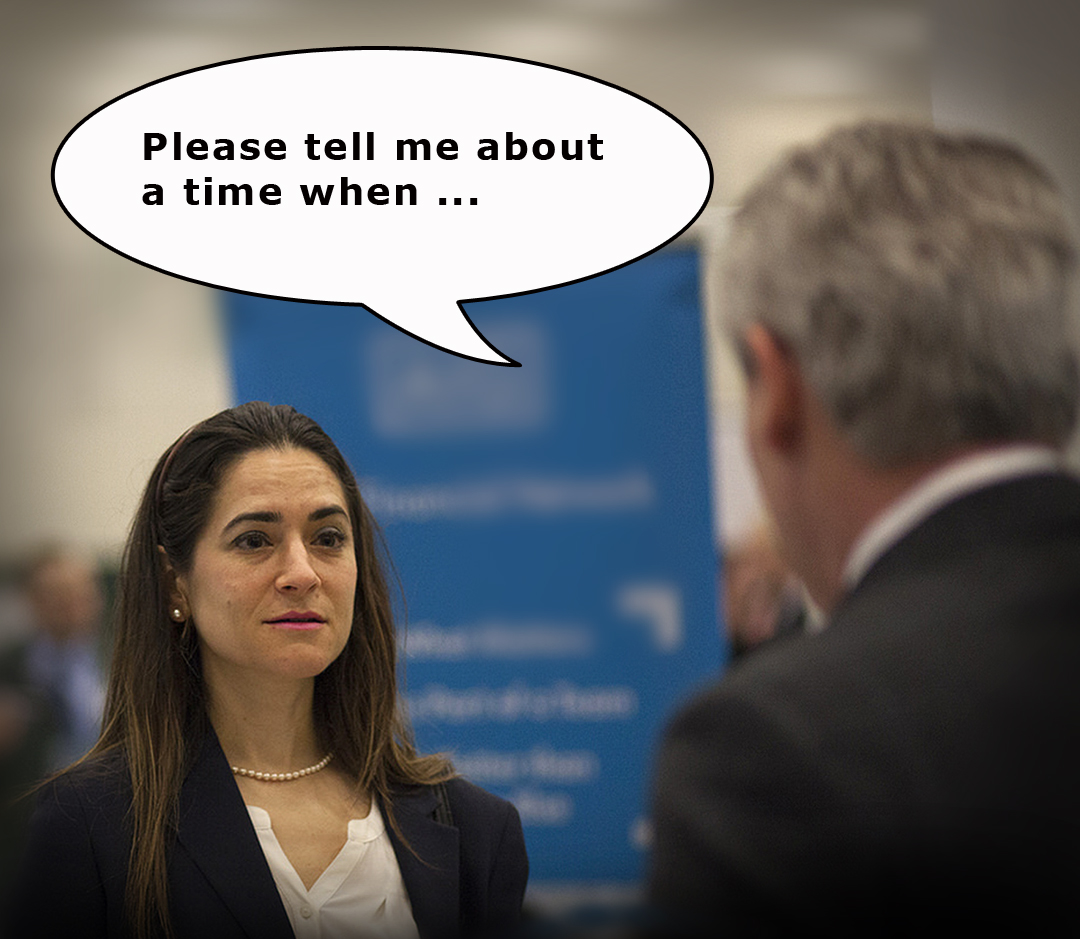 It is no surprise that “STAR” job interviews is one of my most popular podcasts. During a job interview, when the interviewer asks a question that begins with a phrase something like, “Tell me about a time when…,” that is a “behavioral” question. Whether an interview is in-person or online, interviewees often find behavioral-type questions among the most intimidating and challenging. An effective way to answer such questions is using the STAR method.
It is no surprise that “STAR” job interviews is one of my most popular podcasts. During a job interview, when the interviewer asks a question that begins with a phrase something like, “Tell me about a time when…,” that is a “behavioral” question. Whether an interview is in-person or online, interviewees often find behavioral-type questions among the most intimidating and challenging. An effective way to answer such questions is using the STAR method.
Do you know how to use the STAR method?
In this Q&A article, I will briefly discuss the behavioral interview and the STAR method of responding.
Q: What exactly is a behavioral job interview?
A: With this interview type, candidates must recall and describe a past, real-world situation they have experienced relating to a particular behavior as specified by the interviewer.
Q: What do you mean by a “particular behavior?”
A: For example, the interviewer will ask the candidate to describe an actual situation involving a specific issue such as customer service, conflict, stress, honesty, multiple priorities, etc. The resulting behavior in that situation is what is of interest to the interviewer.
Q: Why are interviewers interested in past situations?
A: Behavioral interviews rely on the premise that past behavior is a good predictor of future behavior. In other words, how you handled a past situation involving customer service, conflict, etc., might predict how you are apt to behave in a similar future situation. Your answers may also reveal your true underlying attitudes toward people, work, ethics, and other aspects of life.
Q: How do you know an interview question is a behavioral-type question?
A: Behavioral questions typically begin with an opening phrase such as “Tell me about a time that…” or “Describe for us a time that…” or something similar.
Q: Why are these often referred to as “STAR” interviews?
A: Technically, STAR does not refer to the interview itself, but to the acronym of the preferred approach to answering behavioral-type questions.
Q: Why is the STAR approach such a good way to answer behavioral job interview questions?
A: Quite simply, when a candidate uses the STAR approach, they will answer every aspect of the question asked. Their response will be complete and provide all the details sought by the interviewer. Additionally, recalling the acronym will help the candidate remember to include each required part of the answer.
Q: What does the acronym STAR stand for?
A: STAR is an acronym for Situation, Task, Action, and Result.
Q: What does the “Situation” of STAR mean?
A: In this part of the answer, the candidate briefly describes the background of the overall situation as it relates to the specific behavior specified by the interviewer. For example, the interviewer might ask, “Tell me about a time you had to deal with an irate customer.”
For an irate customer scenario, the candidate might recall a past situation such as the following:
“When I was working as a sales clerk at an electronics store, we were having a sale on a popular tablet. Unfortunately, we didn’t receive our full order of these tablets and therefore didn’t have enough for the advertised sale. There was one customer in particular who was very irate about the item being out of stock, and they began pounding the counter and yelling loudly that they would never shop here again.”
Describing the situation in this manner to the interviewer sets the stage for the rest of the story.
Q: What does the “Task” of STAR mean?
A: The “Task” states what the candidate needed to accomplish in the situation. For example, “I needed to calm the customer, meet their needs, and keep them as a future customer.”
Q: What is the “Action” in STAR?
A: As the term suggests, “Action” describes the specific steps taken to address the task required by the situation. Continuing with the example above, the candidate might say, “First, I calmly conveyed that I was very sorry the item was out of stock and regretted the inconvenience. Next, I offered to ship the tablet from our warehouse directly to their home, with no shipping charge, at the advertised sale price.”
Q: What is the “Result” in STAR?
A: The “Result” in the STAR acronym describes the resulting outcome due to the action taken by the candidate. Concluding the example above, the candidate might conclude by saying, “After I offered this option, the customer calmed considerably and decided to continue with the purchase. By the end of our interaction, the customer was friendly and thanked me for my help in arranging the free delivery.”
Q: Do I need to say the actual words of the acronym, such as “Situation” and so forth, while answering?
A: No, unless the interviewer instructs you to do so, stating the name of each STAR section while answering is usually not required. For example, the complete response for our example might simply go as follows:
“When I was working as a sales clerk at an electronics store, we were having a sale on a popular tablet. Unfortunately, we didn’t receive our full order of these tablets and therefore didn’t have enough for the advertised sale. There was one customer in particular who was extremely irate about the item being out of stock, and they began pounding the counter and yelling loudly that they would never shop here again. I knew I needed to find a way to calm the person, meet their needs, and retain them as a future customer. First, I calmly conveyed that I was very sorry the item was out of stock and regretted the inconvenience. Next, I offered to ship the tablet from our warehouse directly to their home with no shipping charge, at the advertised sale price. After I offered this option, the customer calmed considerably and decided to continue with the purchase. By the end of our interaction, the customer was friendly and thanked me for my help in arranging the free delivery.”
Job interviewers are often time-constrained, so they appreciate brief yet comprehensive answers. Although this response only takes about 60 seconds to recite, it fully addresses the question, providing the interviewer with everything needed to evaluate the answer.
Q: What kinds of behaviors and situations do interviewers usually ask about?
A: While no one can ever predict exactly what will be asked—and the possibilities are endless—most behavioral questions typically fall into categories including, but not limited to:
Adaptability/Stress | Conflict | Leadership/Management |
Customer Service | Honesty/Integrity | Multitasking/Time Management |
Cultural Diversity | Teamwork | Resourcefulness/Problem Solving |
Judgment |
|
|
Q: If the possibilities are endless, how do I prepare for a STAR job interview?
A: Again, while the number of possible questions may be endless, thinking about each of the above categories is a great starting point. When preparing for the interview, recall a situation you experienced related to each. Next, mentally prepare your answer using the STAR approach. After developing each section of STAR, rehearse the complete response aloud. Practicing aloud will help the words come more easily during the interview; however, be careful not to sound overly rehearsed. Considering all the categories in advance has another advantage. If asked a question different from the ones expected or practiced, you still may be able to adapt one of the past situations to the unexpected question. This approach is far easier than trying to recall a past situation on the fly while under the stress of an interview!
Q: In your experience as an interviewer, what are the biggest mistakes candidates make during a behavioral job interview?
A: I find that candidates typically have trouble during a behavioral interview for two reasons:
First, they are either unfamiliar with this type of interview or are ill prepared because they have not given the matter any forethought. Due to the stress of an interview, candidates often become mentally frozen and unable to recall a relevant situation.
Second, the answer given by a candidate is far too vague and does not address the question. For example, if asked about customer service (such as in the above example), a poor response might go something like, “Oh, I am big on customer service. I always provide good service to my customers.” Obviously, this response does not at all answer the question, as the candidate was asked to describe a specific situation and how it was handled. Again, using the STAR approach will help ensure a complete answer.
Q: What are the keys to a successful behavioral job interview?
A: I suggest these three keys to success: 1. Being aware of the premise and purpose of the behavioral job interview. 2. Understanding how to apply the STAR approach when answering behavioral questions. 3. Preparation in advance by recalling situations for typical categories, developing appropriate STAR responses for each, and practicing the responses aloud.
Q: What additional resources about behavioral STAR job interviews are available on Career Lantern?
A: Check out the following Career Lantern podcast and article:
- Using the STAR Method in Behavioral Job Interviews – Podcast CL111
- Behavioral or STAR Job Interview Questions: Are You Ready?
Also, consider ordering a copy of my book The 6 Readiness Factors for Planning, Changing, or Advancing Your Career, available on Amazon.
Agree? Disagree? Feel free to leave a comment and share your experience or thoughts!


 Available in both paperback (8½ x 11 inches) and Kindle edition on
Available in both paperback (8½ x 11 inches) and Kindle edition on